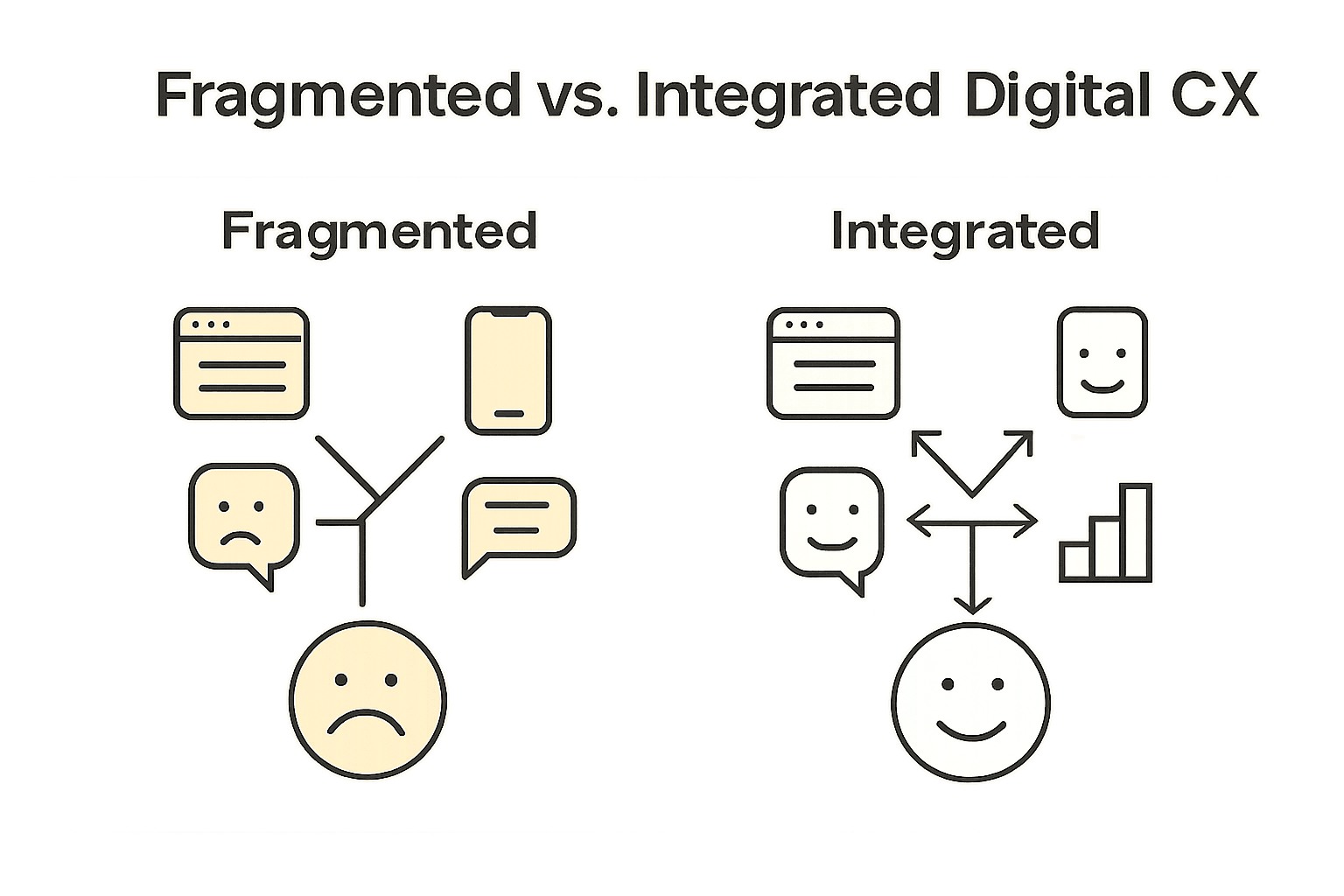Digital CX Explained: Strategies, Benefits, and Tools
Most brands think a flashy website is enough, but research shows that over 70 percent of consumers say their loyalty depends on seamless digital interactions at every stage. As digital journeys become more complex, customers now expect much more than quick purchases or basic support. Understanding what truly shapes digital customer experience helps businesses move beyond old myths and missed opportunities, setting the stage for stronger loyalty and smarter growth.
Table of Contents
- Defining Digital CX And Common Myths
- Types Of Digital CX Channels And Tools
- Key Features Of Effective Digital Experiences
- Practical Benefits And Competitive Advantages
- How To Implement Digital CX Successfully
- Avoiding Pitfalls And Common Mistakes
Key Takeaways
| Point | Details |
|---|---|
| Digital CX is comprehensive | It encompasses all online interactions a customer has with a brand, not just website design. |
| Continuous improvement is essential | Digital CX requires ongoing adaptation and enhancement based on customer feedback and technological advancements. |
| Effective implementation relies on integration | Successful Digital CX involves coordinating technology, data, and communication across various customer touchpoints. |
| Avoid common pitfalls | Businesses should steer clear of fragmented experiences, neglecting customer feedback, and adopting a technology-first approach without customer context. |
Defining Digital CX and Common Myths
Digital Customer Experience (Digital CX) represents the comprehensive set of online interactions a customer has with a brand throughout their entire journey. According to Wikipedia, CX encompasses the cognitive, emotional, sensory, and behavioral responses customers experience across all stages of interaction with a product or service.
At its core, Digital CX goes beyond simple transactional encounters. It’s about creating meaningful, personalised digital touchpoints that transform how customers perceive and engage with a brand. Wikipedia highlights that touchpoints are critical interactions influencing consumer decision-making processes across pre-purchase, purchase, and post-purchase stages.
Some persistent myths about Digital CX can hinder businesses from creating truly exceptional customer experiences. Let’s debunk a few:
-
Myth 1: Digital CX is just about website design
Reality: Digital CX encompasses every digital interaction, including mobile apps, social media, email communication, chatbots, and customer support channels. -
Myth 2: Digital CX is only for tech companies
Reality: Every business, regardless of industry, can benefit from strategic digital customer experience management. -
Myth 3: Digital CX is a one-time implementation
Reality: Successful Digital CX requires continuous monitoring, adaptation, and improvement based on customer feedback and technological advancements.
With the rise of digital technologies, understanding and optimising Digital CX has become crucial for businesses looking to transform their digital strategies. By recognising that Digital CX is a holistic, dynamic process, businesses can create more engaging, personalised, and memorable customer journeys.
Types of Digital CX Channels and Tools
Digital Customer Experience (CX) encompasses a diverse range of channels and tools that enable businesses to interact with customers seamlessly across multiple platforms. Wikipedia emphasises that omnichannel strategies integrate various digital channels, including websites, email, social media, and physical stores, to provide a comprehensive customer experience.
Modern digital CX tools have revolutionised customer interactions, offering multiple touchpoints for engagement. According to Talkdesk, advanced customer service channels now include AI-powered chatbots and live chat solutions that provide real-time support and significantly enhance customer satisfaction.
Here are the primary digital CX channels businesses can leverage:
-
Website Interactions
Comprehensive platform for information, transactions, and customer support -
Mobile Applications
Personalised, on-the-go engagement platforms with advanced features -
Social Media Channels
Direct communication platforms for customer service and brand interaction -
Email Communication
Targeted, personalised messaging for customer engagement and support -
Live Chat and AI Chatbots
Instant, 24/7 customer support with intelligent response mechanisms -
Self-Service Portals
Empowering customers to find solutions independently
Businesses looking to transform their digital strategies can learn more about digital transformation approaches. By implementing a robust, integrated digital CX ecosystem, organisations can create more responsive, engaging customer experiences that drive loyalty and satisfaction.

Key Features of Effective Digital Experiences
Creating exceptional digital experiences requires a multifaceted approach that goes beyond simple functional interactions. According to Wikipedia, effective digital experiences must address various complex dimensions, including sensory perceptions, emotional responses, cognitive evaluations, and behavioral intentions.
Wikipedia highlights that key touchpoints influencing customer experience span multiple critical areas, from technological interfaces to process efficiency and interpersonal interactions. This holistic perspective reveals that truly remarkable digital experiences are not just about technology, but about creating meaningful, contextually rich interactions.
Here are the essential features that define outstanding digital experiences:
-
Intuitive Navigation
Seamless, predictable user journeys that require minimal cognitive effort -
Personalisation
Tailored experiences that adapt to individual user preferences and behaviours -
Performance and Speed
Rapid loading times and responsive interfaces that respect user time -
Accessibility
Inclusive design that ensures usability for users with diverse abilities -
Consistent Omnichannel Experience
Unified interactions across multiple platforms and touchpoints -
Emotional Engagement
Experiences that create positive emotional connections beyond transactional interactions
Small businesses can enhance their digital experience by exploring user experience design principles. By understanding and implementing these key features, organisations can transform digital interactions from mere transactions into memorable, meaningful experiences that build long-term customer loyalty.
Practical Benefits and Competitive Advantages
Implementing a robust Digital Customer Experience (CX) strategy offers businesses substantial strategic advantages that extend far beyond simple technological upgrades. Wikipedia reveals that a positive customer experience can lead to increased customer loyalty, higher customer lifetime value, and a stronger competitive position in the market.
The strategic implications of digital CX are profound. Wikipedia highlights how implementing omnichannel strategies enables organisations to enhance inventory visibility and availability, directly translating into improved customer satisfaction and a significant competitive edge.
Here are the key practical benefits businesses can realise through effective digital CX:
-
Enhanced Customer Retention
Reducing customer churn by creating memorable, personalised experiences -
Operational Efficiency
Streamlining processes and reducing customer support costs through intelligent digital channels -
Data-Driven Insights
Gathering rich customer interaction data to inform strategic decision-making -
Brand Differentiation
Creating unique, memorable digital interactions that set your brand apart -
Cost Reduction
Automating customer service processes and reducing manual intervention -
Scalable Growth
Building digital infrastructure that can expand with your business needs
Businesses seeking to transform their operational approach can explore comprehensive digital transformation strategies. By strategically investing in digital customer experience, organisations can create a sustainable competitive advantage that drives long-term growth and customer loyalty.
How to Implement Digital CX Successfully
Successful digital CX implementation requires a strategic, holistic approach that goes beyond simple technological deployment. Wikipedia emphasises that effective implementation involves seamlessly integrating data, technology, content, and communication across multiple channels to coordinate customer interactions effectively.
Wikipedia highlights the critical importance of managing touchpoints, ensuring a consistent brand experience across all interfaces by optimising interactions with existing and potential customers. This approach demands a comprehensive understanding of customer journeys and strategic alignment of technological capabilities.
Here are the key steps to implement digital CX successfully:
-
Customer Journey Mapping
Deeply understand and document every interaction point and customer experience stage -
Technology Integration
Select and interconnect digital tools that provide seamless, unified customer experiences -
Data Strategy
Implement robust data collection and analysis mechanisms to drive personalisation -
Continuous Feedback Loop
Establish mechanisms for constant customer insights and iterative improvements -
Cross-Functional Alignment
Ensure all departments collaborate towards a unified customer experience vision -
Training and Culture
Develop a customer-centric organisational culture that prioritises digital experience
Businesses ready to transform their approach can learn comprehensive strategies for digital transformation. By methodically implementing these principles, organisations can create digital customer experiences that not only meet but exceed customer expectations, driving loyalty and sustainable growth.
Avoiding Pitfalls and Common Mistakes
Navigating digital customer experience requires strategic awareness and proactive management of potential challenges. Wikipedia warns that failing to identify and evaluate all relevant touchpoints can lead to inconsistent brand experiences and missed opportunities for customer engagement.
Wikipedia emphasises that neglecting to integrate various channels effectively can result in disjointed customer experiences and reduced customer satisfaction. Understanding these potential pitfalls is crucial for businesses seeking to create seamless, compelling digital interactions.
Here are the most critical mistakes to avoid in digital CX implementation:
-
Fragmented Channel Experiences
Allowing inconsistent messaging and experiences across different digital platforms -
Overlooking Customer Feedback
Failing to establish continuous learning and improvement mechanisms -
Technology-First Approach
Implementing digital tools without understanding actual customer needs -
Neglecting Data Privacy
Mishandling customer data or failing to maintain transparent data practices -
Ignoring User Experience Design
Creating complex, unintuitive digital interfaces that frustrate users -
Lack of Personalization
Treating all customers with a one-size-fits-all digital strategy
Businesses committed to digital excellence can explore comprehensive digital transformation strategies. By proactively addressing these potential pitfalls, organisations can develop robust, customer-centric digital experiences that truly differentiate them in a competitive marketplace.

Elevate Your Digital Customer Experience with Smart Automation
Many small businesses struggle with creating seamless, personalised digital experiences that truly engage customers. This article highlights challenges such as fragmented channel interactions and the need for continuous adaptation—common pain points that slow growth and diminish customer loyalty. If you want to move beyond inconsistent touchpoints and embrace strategic digital CX improvements, automating your workflows and integrating intelligent tools is essential.
At Fame Razak, we specialise in turning everyday operations into scalable systems that support exceptional digital customer experiences. From automating client onboarding to deploying AI receptionists, our solutions help eliminate repetitive tasks so your team can focus on building meaningful customer relationships. Don’t let digital CX challenges hold you back. Discover practical ways to transform your digital strategy now by exploring our digital transformation guide and learning about user experience design principles. Take the next step to create personalised, efficient, and memorable digital interactions today.
Frequently Asked Questions
What is Digital Customer Experience (Digital CX)?
Digital Customer Experience (Digital CX) refers to the complete set of online interactions a customer has with a brand throughout their journey, focusing on creating meaningful, personalized touchpoints that enhance customer engagement and satisfaction.
What are the key features of effective Digital CX?
Effective Digital CX features include intuitive navigation, personalization, performance and speed, accessibility, consistent omnichannel experiences, and emotional engagement, all of which work together to create memorable user interactions.
How can businesses successfully implement Digital CX strategies?
Businesses can implement Digital CX by mapping customer journeys, integrating technology, establishing a data strategy, creating continuous feedback loops, aligning cross-functional teams, and fostering a customer-centric culture within the organization.
What are the benefits of investing in Digital CX?
Investing in Digital CX offers benefits such as enhanced customer retention, operational efficiency, data-driven insights for decision-making, brand differentiation, cost reduction through automation, and scalable growth to support business expansion.
Recommended
- What Is Digital First? Complete Guide for Businesses – Fame Razak
- How to Lead Digital Transformation for Scalable Success – Fame Razak
- Complete Guide to Digital Transformation in Business – Fame Razak
- Digital Resilience Explained: Complete 2025 Guide – Fame Razak
- Waarom Personalisatie In Campagnes: Complete Gids – Re:Positive
- Role of Digital Transformation: Complete Guide for Retailers | Reddog Consulting Group
